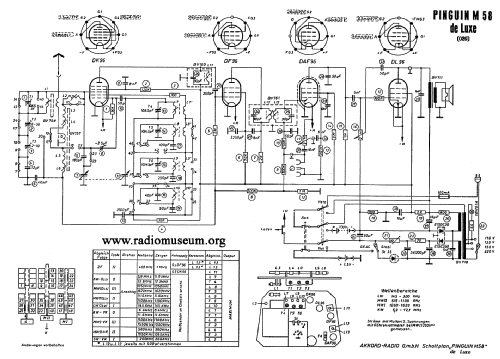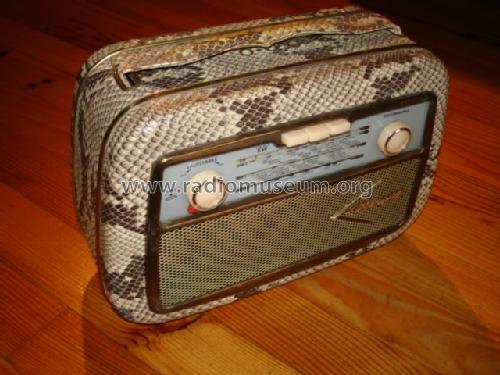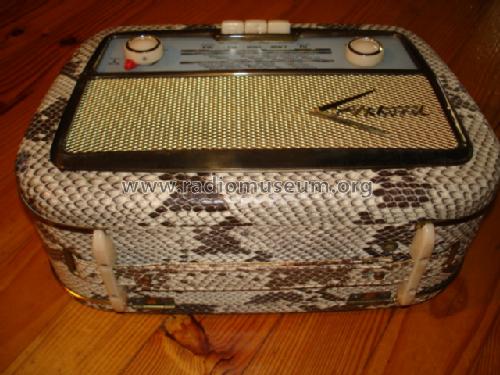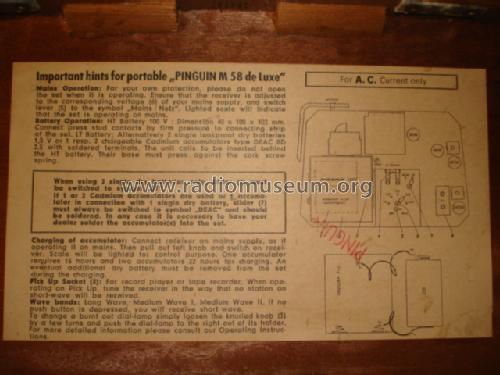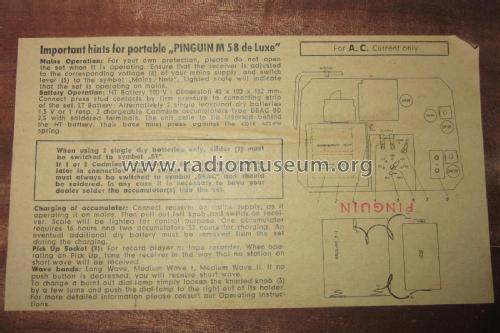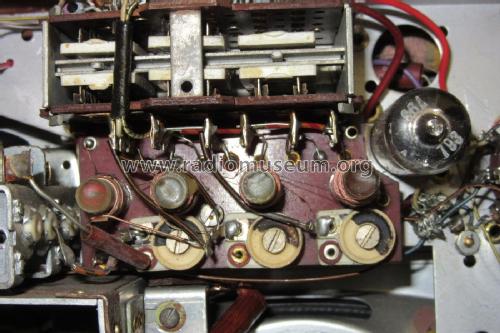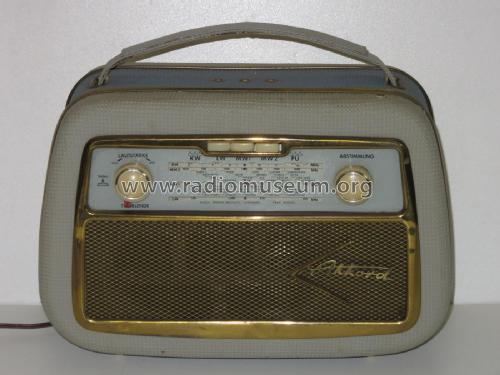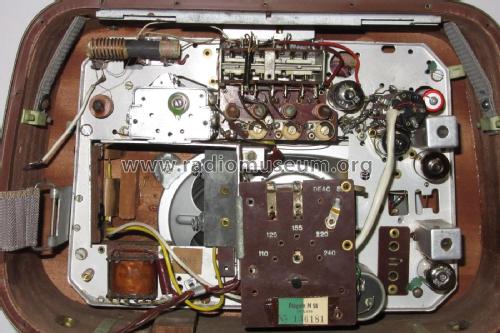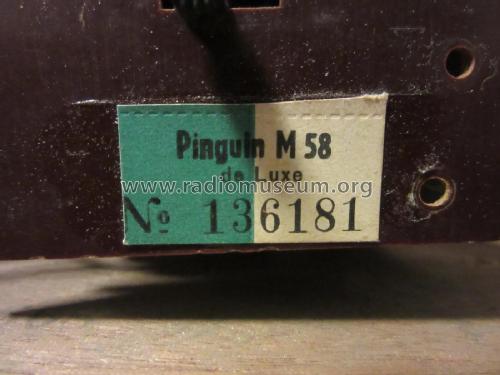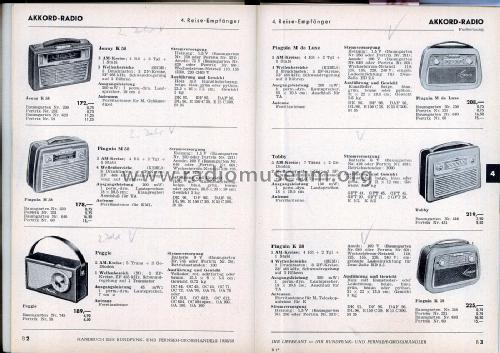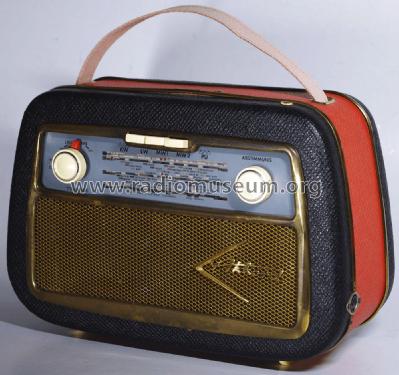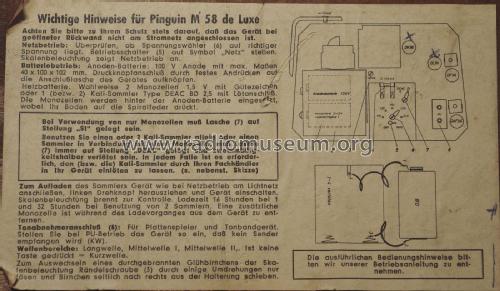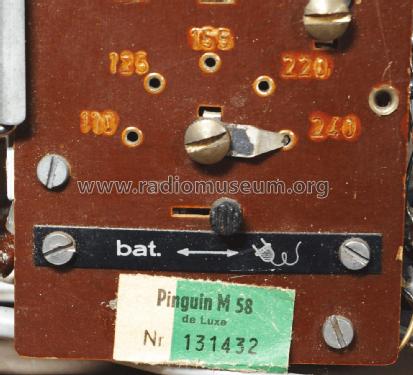Pinguin M58 de Luxe
Akkord-Radio + Akkord Elektronik (Radios)
- Country
- Germany
- Manufacturer / Brand
- Akkord-Radio + Akkord Elektronik (Radios)
- Year
- 1958/1959
- Category
- Broadcast Receiver - or past WW2 Tuner
- Radiomuseum.org ID
- 364
Click on the schematic thumbnail to request the schematic as a free document.
- Number of Tubes
- 4
- Number of Transistors
- Main principle
- Superheterodyne (common); ZF/IF 468 kHz
- Tuned circuits
- 5 AM circuit(s)
- Wave bands
- Broadcast, Long Wave and Short Wave.
- Power type and voltage
- Line / Batteries (any type) / 110; 125; 155; 220; 240 / 1,5 & 100 Volt
- Loudspeaker
- Permanent Magnet Dynamic (PDyn) Loudspeaker (moving coil) - elliptical
- Power out
- 0.2 W (unknown quality)
- Material
- Leather / canvas / plastic - over other material
- from Radiomuseum.org
- Model: Pinguin M58 de Luxe - Akkord-Radio + Akkord
- Shape
- Portable set > 8 inch (also usable without mains)
- Dimensions (WHD)
- 310 x 220 x 135 mm / 12.2 x 8.7 x 5.3 inch
- Notes
-
Eingebaute Ladeeinrichtung für Deac-Zelle BD2,5. Wellenbereiche:
- LW = 150 kHz - 300 kHz
- MW1 = 520 kHz - 1100 kHz
- MW2 = 1050 kHz - 1600 kHz
- KW = 6 MHz - 12 MHz
- Net weight (2.2 lb = 1 kg)
- 3.6 kg / 7 lb 14.9 oz (7.93 lb)
- Price in first year of sale
- 208.00 DM
- Source of data
- HdB d.Rdf-& Ferns-GrH 1958/59 / Radiokatalog Band 1, Ernst Erb
- Other Models
-
Here you find 200 models, 181 with images and 140 with schematics for wireless sets etc. In French: TSF for Télégraphie sans fil.
All listed radios etc. from Akkord-Radio + Akkord Elektronik (Radios)
Collections
The model Pinguin is part of the collections of the following members.
Forum contributions about this model: Akkord-Radio +: Pinguin M58 de Luxe
Threads: 1 | Posts: 3
Bei einem Sammlerstück im schlechten äusseren Zustand, Akkord Pinguin M58 de Luxe, hatten sich im Laufe der vielen Jahre die Standfüsse aufgelöst. Fragmente fehlten, Rest verformt.
Hier bot sich eine rel. einfache Neuanfertigung aus Holz an.
Arbeitsgänge
1.) Maße von vorhanden guten Teilen oder den Teileresten auf Holzleiste übertragen.
2.) Grobbearbeitung: Sägen, Grobfeilen/Raspeln.
3.) Feinschleifen, Löcher bohren.
4.) Grundieren, nach dem Trocknen noch einmal feinschleifen.
5.) Endlackieren mit Spray elfenbein-farbig.
Das Radio mit den defekten Füssen
Muster eines gleichen Gerätes
Ersatz aus Holz roh
Grundierung
Lackiert
Ersatzfüsse montiert
Schlussbetrachtung
Beim nächsten Mal würde ich eine Leiste aus Hartholz, z.B. Buche, verwenden, weil dadurch eine glattere Oberfäche möglich ist.
Hans-Werner Ellerbrock, 04.Sep.17
